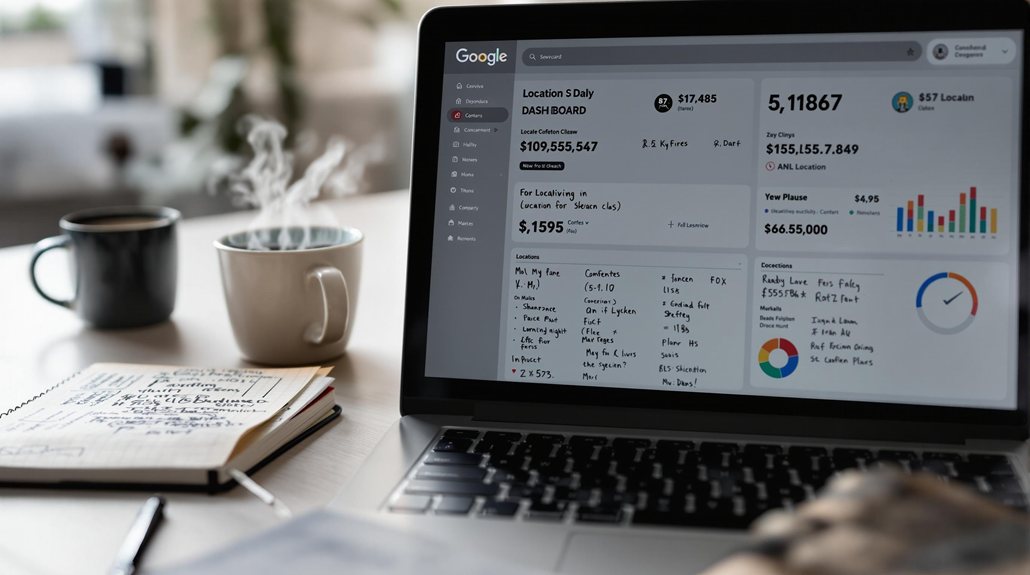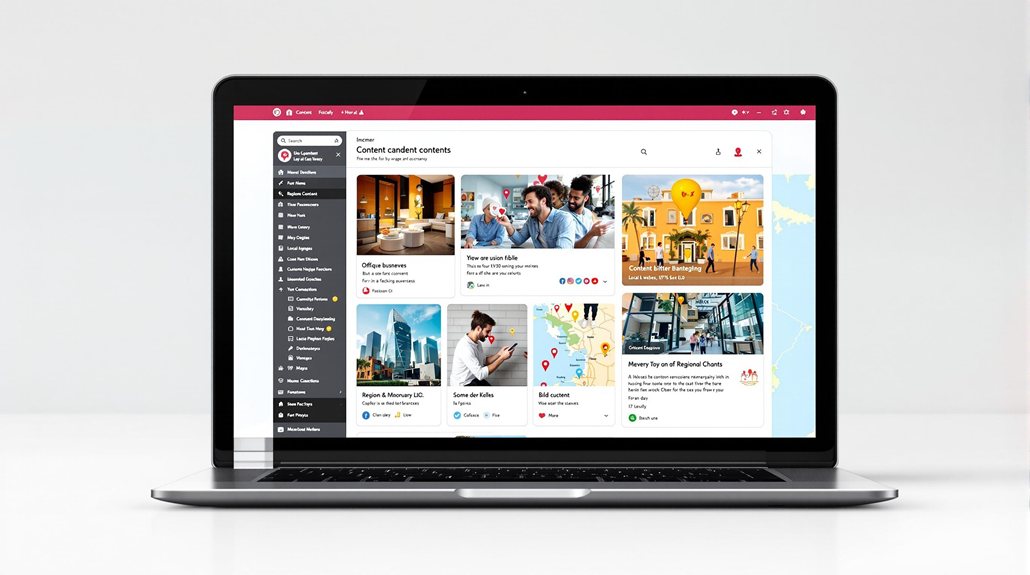As a multi-location business, you must craft unique, location-specific content to effectively reach and engage your target customers. Prioritize your primary Google Business Profile category, fill out all sections, and leverage local insights. Incorporate reviews, maintain consistent NAP data, and use geo-targeted keywords in your content. Analyze local culture, stay updated on trends, and personalize engagement to build trust. Explore how to take your location-based content strategy to the next level.
Enhancing Local Search Visibility

If you want to enhance your local search visibility, it's crucial to understand how consumers search for businesses in your area. Nearly half of all Google searches have local intent, and over three-quarters of those searchers visit a local business within a day. Optimize your Google Business Profile by prioritizing the primary category, filling out all sections, and keeping your information current. Leverage local insights and landmarks by mentioning regional references and upcoming events to resonate with your community. 92% of local SEO and marketing professionals claim to have experimented with ChatGPT. Reviews also play a significant role, as 90% of consumers read them before visiting a business. Incorporating these strategies can help your multi-location business stand out in local search results.
Crafting Unique Content for Each Location

As a multi-location business, you must create content that resonates with the distinct cultural nuances, preferences, and lifestyles of each local audience. Adapting messaging and visuals to meet unique cultural and environmental characteristics of each local audience can help foster stronger connections. Analyze the local culture, tailor messaging, and incorporate unique features like landmarks and events. Understand consumer preferences and demonstrate empathy for local traditions. Stay updated on market trends, use local dialects, and discuss environmental and lifestyle patterns. Personalize engagement, adjust branding, foster community, and integrate customer feedback. Highlight local success stories, showcase customer testimonials, and emphasize your positive impact on the community. Collaborate with local influencers, publish in local media, and participate in community events to build lasting relationships.
Geo-Targeting in Titles and Metadata

Effective geo-targeting in your titles and metadata is crucial for multi-location businesses seeking to rank highly in local search results and resonate with distinct regional audiences. Incorporate location-specific keywords in your title tags to signal relevance to search engines. Avoid cramming multiple city names into a single title; instead, use dedicated location-based pages. Leverage meta descriptions to reinforce your geographic focus and include relevant local details. Ensure your URL structure aligns with your geo-targeting strategy for a user-friendly experience. Optimizing your Google My Business profiles with accurate local data is equally vital to improve visibility in local search. Continuously monitor and optimize your geo-targeting approach to effectively reach your target audience in each location.
Consistent NAP Across All Platforms
Maintaining consistent NAP (Name, Address, and Phone number) data across all platforms is crucial for multi-location businesses seeking to enhance their local search visibility and credibility. Inaccurate or inconsistent NAP information can confuse potential customers and damage your business reputation. To maintain NAP consistency:
- Leverage Google My Business to manage and update NAP details across your locations.
- Ensure your NAP data is accurate and uniform on Facebook, online directories, and social media profiles.
- Conduct regular audits to identify and correct any inconsistencies in your business listings.
- Implement a standardized process for updating NAP information to avoid future discrepancies.
- Leverage local partnerships for cross-promotion and additional citation opportunities to further strengthen your NAP consistency.
Leveraging Local Backlinks
As a multi-location business, you understand the importance of local backlinks. These links signal to search engines that your company is credible and relevant within specific geographic areas. By leveraging local partnerships, community involvement, and media outreach, you can effectively boost your authority and visibility through locality-driven backlinks. Partnering with local businesses for link exchanges can be a powerful way to build your local SEO presence.
Boosting Authority With Locality
Boosting your authority through locality is paramount when establishing a strong online presence for your multi-location business. By leveraging location-specific keywords, hyperlocal content, and expert insights tailored to each region, you can enhance your relevance and credibility with your target audiences. Managing NAP (Name, Address, Phone Number) consistency across platforms is crucial for maintaining accurate business listings across various directories and platforms. Moreover, engaging with the local community, securing sponsorships, and collaborating with nearby businesses can bolster your visibility and strengthen your backlink profile. Additionally, maintaining accurate Google My Business listings, encouraging customer reviews, and optimizing for voice search can further elevate your authority in the eyes of both search engines and potential customers.
- Utilize location-specific keywords and hyperlocal content.
- Participate in local events and secure sponsorships.
- Maintain accurate Google My Business listings and reviews.
- Optimize for voice search and mobile-friendly experiences.
Earning Credible Backlinks
Now that you've established a strong foundation by boosting your authority through locality, it's time to focus on earning credible backlinks to further cement your multi-location business's online presence. Backlinks are a key ranking factor for search engines, and local news sites, community organizations, and other relevant businesses in your geographic area can provide valuable backlinks that improve your relevance for local searches. Avoid manipulative tactics and instead focus on organic, ethical link-building strategies, such as participating in local events, listing your business on directories, and collaborating with local partners. This approach not only builds credibility but also expands your network within the community.
| Sources of Local Backlinks | Importance of Relevance | Avoiding Manipulation |
|---|---|---|
| Local news sites | Improve local search relevance | Avoid purchased links |
| Community organizations | Enhance geographic relevance | Focus on ethical strategies |
| Local businesses | Strengthen local authority | Participate in organic outreach |
Building Brand Loyalty Through Personalization
Personalization is the cornerstone of building brand loyalty in today's competitive landscape. You must understand your customers' individual needs and preferences to deliver seamless, customized experiences. Consumers are more than twice as likely to view personalized offers as important than unimportant. Consider these four strategies to boost loyalty through personalization:
- Leverage customer data to craft personalized content that resonates.
- Customize the customer journey at every touchpoint for maximum impact.
- Prioritize omnichannel personalization to provide a cohesive brand experience.
- Continuously optimize your personalization efforts based on customer feedback and evolving expectations.
Brands that excel at personalization reap significant rewards, including higher revenue, increased customer loyalty, and stronger brand affinity. Stay ahead of the curve by making personalization a strategic priority for your multi-location business.
Fostering Cultural Relevance and Engagement
Tailoring your content to local audiences is crucial for fostering cultural relevance and engagement. By understanding regional preferences and incorporating culturally appropriate elements, you can create content that resonates deeply with your customers. Effective multi-location marketing campaigns help stay ahead of the competition and build trust. Enhancing these cultural connections will not only boost your brand's visibility but also strengthen loyalty among your diverse consumer base.
Tailoring Content Locally
Because local relevance is essential for multi-location businesses, you must tailor your content to each market's unique cultural nuances and consumer behavior. This includes incorporating geo-specific keywords, understanding local market dynamics, utilizing various content formats, and highlighting relevant local traditions and events. Leveraging FAQs for Enhanced Local SEO can also help businesses showcase their expertise and commitment to the community's needs.
To create locally relevant content, you should focus on:
- Location-specific landing pages
- High-quality visuals related to local landmarks
- Storytelling techniques that capture the local audience's imagination
- User-generated content from your local customers
Resonating With Audiences
Fostering cultural relevance and audience engagement are paramount for multi-location businesses. Understanding cultural diversity in your locations is crucial. Adapt content to local norms, monitor social media trends, and highlight relevant local events. Collaborate with local experts to avoid misunderstandings and enhance authenticity. Utilize interactive tools like polls and surveys to engage audiences directly. Employ various content channels to reach diverse segments. Respond thoughtfully to reviews, and get involved in local communities. Maintain consistent brand messaging and voice while localizing content. Leverage technology for targeted advertising, SEO optimization, and influencer partnerships. Develop content that addresses local needs and preferences to maximize effectiveness.
Enhancing Cultural Connections
Multifaceted cultural connections are vital for multi-location businesses seeking to engage diverse audiences. By weaving local customs, events, and themes into your marketing efforts, you can create a strong sense of cultural relevance and resonance. Consider these strategies:
- Tailor content to reflect regional preferences and identities, fostering a deeper connection with your audience.
- Partner with local influencers or organizations to gain valuable insights and leverage their cultural credibility.
- Adapt store layouts, product offerings, and service experiences to cater to unique local tastes and expectations.
- Gather continuous feedback from customers to guide your cultural adaptation efforts and ensure ongoing relevance.
Differentiating From Competitors
Differentiating your multi-location business from competitors is key to standing out in crowded markets. Develop a localized content strategy that highlights each location's unique offerings and services. Maintain a consistent brand voice while adapting messaging for local contexts to preserve your identity. Conduct thorough keyword research to identify gaps in competitors' strategies and optimize your content. Crafting unique value propositions for each location based on local preferences sets you apart. Leverage location-specific customer reviews and testimonials to enhance credibility and trust. Adapt your content to regional preferences, using data-driven insights on consumer behavior to inform effective localized marketing strategies.
Connecting With Local Communities
Connecting with local communities is crucial for multi-location businesses to thrive. By identifying potential partners, engaging in local events, supporting causes, and utilizing social media, you can build strong community ties.
Here are 4 ways to connect with your local communities:
- Partner with organizations that align with your values to enhance your brand reputation and attract more customers.
- Sponsor local sports teams or host workshops to establish your business as a knowledgeable community resource.
- Align with charities, organize fundraisers, and volunteer to deepen community bonds and boost customer loyalty.
- Engage on social media, respond to local conversations, and collaborate with influencers to increase your local presence.
Meeting Regional Consumer Needs
Understanding the unique preferences of consumers in different regions is key. Tailoring your product assortment to match local demands can drive sales. Adapting your communication channels to resonate with regional audiences is equally important.
Understanding Local Preferences
As a multi-location business, you'll need to consider the distinct regional preferences of your consumers. This may include:
- Prioritizing local product origins in Germany and Austria, while being less important in the UK and US.
- Catering to dollar store shoppers in the South, club store enthusiasts in the West, and gas/convenience store patrons in the Midwest.
- Embracing mobile payments and self-checkout systems to meet the demand for convenient, technology-driven shopping experiences.
- Adjusting your product assortment to reflect regional dietary shifts, such as increased fresh produce and reduced red meat consumption.
Understanding these nuanced local preferences is crucial for crafting content that resonates with your target audience across your multiple locations.
Tailoring Product Assortment
Tailoring your product assortment to meet the unique regional consumer needs is crucial for multi-location businesses. By analyzing customer data, market trends, and seasonality, you can curate localized assortments that boost sales, improve inventory turnover, and enhance the customer experience. Leverage technology to identify micro-regional patterns and adjust your inventory accordingly. Offer a balanced product mix with varying depths to cater to diverse tastes, while maintaining operational flexibility. Defining your target markets, allocating resources effectively, and regularly monitoring performance are key to successfully implementing a strategic assortment plan. Aligning your marketing efforts with tailored product offerings will further strengthen your brand's relevance in each local market.
Adapting Communication Channels
Effective communication channels are paramount for multi-location businesses in meeting the diverse needs of regional consumers. By implementing centralized platforms, you can enhance information flow and streamline communication across all locations. Ensuring role-based access helps employees see only relevant information, improving efficiency. Integrating various communication tools, from social intranets to instant messaging, fosters coherence. Regular cross-location interactions, such as video calls and team-building activities, can reduce operational silos and promote collaboration.
- Standardize communication protocols to ensure no team is left behind.
- Utilize multiple channels like email, instant messaging, and digital signage for broader reach.
- Adapt content and messaging to suit regional consumer preferences and cultural sensitivities.
- Leverage unified digital platforms with real-time updates and collaborative capabilities.
Displaying NAP on Location Pages
Displaying your business's NAP (Name, Address, Phone number) prominently on your location pages is essential for enhancing user experience and bolstering local SEO. Ensure your NAP is in crawlable HTML text, not images, so search engines can index it. Place the NAP in your site's header or footer to maintain visibility across all pages. For multi-location businesses, include the specific NAP for each location on its respective page or have a centralized page listing all locations. Consistent NAP boosts local SEO by signaling authenticity to search engines and builds trust with potential customers. Optimize your NAP for mobile, prioritize fast loading speeds, and use a standardized format to reinforce professionalism.
Utilizing Structured Data
Utilizing structured data can enhance search engine understanding of your multi-location business. By leveraging schema markup like Organization, LocalBusiness, and Department, you can provide accurate details about each branch's location, services, and parent company. This structured approach boosts visibility in search results and improves the customer experience through detailed, consistent business information.
Enhance Search Understanding
How can structured data help you enhance search engine understanding of your website content? By providing explicit clues about the meaning of your pages, structured data enables search engines like Google to better comprehend your content. This results in rich snippets that highlight key information, such as ratings, images, and descriptions. Structured data is essential for improving your search rankings, as it clarifies your content's relevance for search engines. Here are 4 key benefits:
- Increased click-through rates
- Enhanced user interaction
- Improved search positioning
- Enablement of future search features
Implementing structured data is crucial for multi-location businesses to ensure search engines accurately understand and display your content.
Structured Schema Markup
While implementing structured schema markup is crucial for multi-location businesses, it's important to understand the various schema types and how to apply them effectively. For physical store locations, the LocalBusiness schema is ideal, while the Organization schema suits services in multiple locations. Additionally, the WebSite schema provides overall business information, the FAQ schema answers customer questions, and the Review schema enhances credibility with ratings. When marking up multiple locations, use the "department" property, ensure unique "@id" properties, and apply schema in JSON-LD format. This approach improves visibility in local search, enhances rich results, and supports a better content strategy with structured data.
Optimized Business Details
Optimizing business details for multi-location enterprises is crucial, as it ensures customers can easily find and interact with your brand across various touchpoints. To achieve this, you should:
- Maintain consistent name, address, and phone number (NAP) information across all listings to boost search engine visibility.
- Leverage Google My Business to manage multiple locations under a single account, streamlining updates and optimizations.
- Create distinct listings for each location to provide accurate, localized information to customers.
- Utilize high-quality visuals to highlight the unique features and offerings of each location.
Incorporating Customer Reviews
As a multi-location business, you can't underestimate the power of customer reviews. They serve as a trust factor, influencing 71% of customers' perceptions. Reviews also impact pre-purchase research, with 86% of customers reading them before visiting. Effectively managing reviews across platforms like Yelp, Google, and social media can drive revenue by building credibility. Utilize a centralized or decentralized approach, balance personal touch, and leverage automated systems to streamline review responses. Collect feedback proactively, display positive testimonials, and analyze data to identify trends and top-performing locations. By incorporating customer reviews into your multi-location content strategy, you can enhance your brand's reputation and attract more customers.
Integrating Google Maps
Integrating Google Maps is crucial for multi-location businesses to improve visibility and make it easier for customers to find and engage with their locations. Google's features allow you to import multiple locations using a template, simplifying the process for large chains. The verification process includes options like phone, email, video, or postcard, with bulk verification available for ten or more locations. Additionally, utilizing Google Maps APIs can provide more advanced mapping features and customization for your business listings.
- Accurate listing of business locations helps customers find and engage with your business more easily.
- Consistent business information across locations is important for building trust with customers.
- Optimizing your Google Maps presence is vital for improving local search rankings.
- Creating custom maps can organize your locations visually for easier customer navigation.
Employing Location-Specific Calls-to-Action
Enhancing your multi-location business's online presence goes beyond simply integrating Google Maps. Employing location-specific calls-to-action (CTAs) can significantly boost engagement, improve local SEO, and enhance user experience. Craft actionable CTAs like "Call Our Dallas Office" to guide users. Incorporate local keywords and references to make CTAs relatable. Leverage visuals like maps to emphasize the local focus. Highlight community involvement to reinforce your connection. Analyze performance data to refine strategies for each location. Integrate location-specific CTAs with your broader marketing platforms for seamless execution. By tailoring content and CTAs to local needs, you can gain a competitive edge and drive higher conversions.
